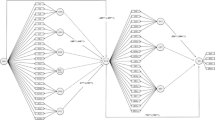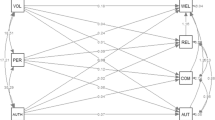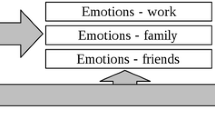Abstract
Introversion–extraversion is a particularly salient personality trait, whereby “extraverts” are known to be more outgoing, bold, assertive, active, and cheerful than “introverts”. These extraverted attributes are socially desirable in individualistic Western cultures, and some evidence suggests that extraverts experience better person-environment fit and greater well-being than introverts in these cultures. However, what remains unclear is how living in a context that values and emphasises extraversion may impact upon the well-being of introverts, and how introverts might improve their well-being. This study aimed to explore this question via a moderated mediation model. Adult participants in Australia (N = 349) completed scales of trait introversion–extraversion, dispositional authenticity, and well-being. The extent to which participants wanted to be more extraverted than they were currently—labelled an extraversion-deficit belief—was also measured. Participants overwhelmingly indicated that they lived in a society where extraversion was more socially desirable than introversion, and most participants held extraversion-deficit beliefs. Moderated mediation analysis showed that higher trait introversion–extraversion predicted well-being directly as well as indirectly via dispositional authenticity, but this indirect pathway depended on extraversion-deficit beliefs. Extraversion-deficit beliefs were more important for the authenticity and well-being of introverts than for extraverts. Overall, we interpret our findings to mean that introverts in the West might be more authentic, and hence boost their overall well-being, if they can change their beliefs to become more accepting of their introversion.



Similar content being viewed by others
References
Anderson, C., John, O. P., Keltner, D., & Kring, A. M. (2001). Who attains social status? Effects of personality and physical attractiveness in social groups. Journal of Personality and Social Psychology, 81(1), 116–132.
Barrett-Lennard, G. T. (1998). Carl Rogers’ helping system: Journey and substance. London: SAGE Publications.
Bastian, B., Kuppens, P., De Roover, K., & Diener, E. (2014). Is valuing positive emotion associated with life satisfaction? Emotion, 14(4), 639–645.
Baumeister, R. F. (1997). Identity, self-concept, and self-esteem: The self lost and found. In R. Hogan, J. Johnson, & S. Briggs (Eds.), Handbook of personality psychology (pp. 681–710). San Diego, CA: Academic Press.
Baumeister, R. F., & Leary, M. R. (1995). The need to belong: Desire for interpersonal attachments as a fundamental human motivation. Psychological Bulletin, 117, 497–529.
Cain, S. (2012a). Quiet: The power of introverts in a world that can’t stop talking. London: Penguin Books.
Cain, S. (2012b). Susan cain: The power of introverts [Video file]. Retrieved from https://www.ted.com/talks/susan_cain_the_power_of_introverts. Accessed 9 Apr 2018.
Darlington, R. B., & Hayes, A. F. (2017). Regression analysis and linear models: Concepts, applications, and implementation. New York, NY: The Guilford Press.
Davidson, L. (2004). Integrity [authenticity, honesty]. In C. Peterson & M.E.P. Seligman (Eds.), Character strengths and virtues: A handbook and classification (pp. 249–271). Washington, DC, and New York, NY: American Psychological Association, and Oxford University Press.
Davidson, B., Gillies, R. A., & Pelletier, A. L. (2015). Introversion and medical student education: Challenges for both students and educators. Teaching and Learning in Medicine: An International Journal, 27(1), 99–104.
DeYoung, C. G. (2015). Cybernetic big five theory. Journal of Research in Personality, 56, 33–58.
Dweck, C. S. (2000). Self-theories: Their role in motivation, personality, and development. Philadelphia, PA: Psychology Press.
Dweck, C. S. (2008). Can personality be changed? The role of beliefs in personality and change. Current Directions in Psychological Science, 17(6), 391–394.
Fleeson, W. (2001). Toward a structure-and-process-integrated view of personality: Traits as density distributions of states. Journal of Personality and Social Psychology, 80(6), 1011–1027.
Fleeson, W. (2007). Situation-based contingencies underlying trait-content manifestation in behavior. Journal of Personality, 75(4), 825–862.
Fleeson, W., & Wilt, J. (2010). The relevance of Big Five trait content in behaviour to subjective authenticity: Do high levels of within-person behavioural variability undermine or enable authenticity achievement? Journal of Personality, 78(4), 1353–1382.
Fulmer, C. A., Gelfand, M. J., Kruglanski, A. W., Kim-Prieto, C., Diener, E., Pierro, A., et al. (2010). On “feeling right” in cultural contexts: How person-culture match affects self-esteem and subjective well-being. Psychological Science, 21(11), 1563–1569.
Furnham, A., & Henderson, M. (1982). The good, the bad and the mad: Response bias in self-report measures. Personality and Individual Differences, 3(3), 311–320.
Furnham, A., & Henderson, M. (1983). The mote in thy brother’s eye, and the beam in thine own: Predicting one’s own and others’ personality test scores. British Journal of Psychology, 74(3), 381–389.
Goldberg, L. R., Johnson, J. A., Eber, H. W., Hogan, R., Ashton, M. C., Cloninger, C. R., et al. (2006). The international personality item pool and the future of public-domain personality measures. Journal of Research in Personality, 40(1), 84–96.
Hayes, A. F. (2013). Introduction to mediation, moderation, and conditional process analysis: A regression-based approach. New York, NY: The Guilford Press.
Hayes, A. F. (2015). An index and test of linear moderated mediation. Multivariate Behavioral Research, 50(1), 1–22.
Hayes, A. F., & Cai, L. (2007). Using heteroskedasticity-consistent standard error estimators in OLS regression: An introduction and software implementation. Behavior Research Methods, 39(4), 709–722.
Higgins, E. T. (1987). Self-discrepancy: A theory relating self and affect. Psychological Review, 94(3), 319–340.
Higgins, E. T. (2000). Social cognition: Learning about what matters in the social world. European Journal of Social Psychology, 30(1), 3–39.
Hills, P., & Argyle, M. (2001). Happiness, introversion–extraversion and happy introverts. Personality and Individual Differences, 30(4), 595–608.
Hofstede, G., & McCrae, R. R. (2004). Personality and culture revisited: Linking traits and dimensions of culture. Cross-Cultural Research, 38(1), 52–88.
Hogan, R. (1983). A socioanalytic theory of personality. In M. Page (Ed.), Nebraska symposium on motivation, 1982: Personality—current theory and research (Vol. 29, pp. 55–89). Lincoln: University of Nebraska Press.
Hudson, N. W., & Roberts, B. W. (2014). Goals to change personality traits: Concurrent links between personality traits, daily behaviour, and goals to change oneself. Journal of Research in Personality, 53, 68–83.
International Personality Item Pool: A scientific collaboratory for the development of advanced measures of personality traits and other individual differences (http://ipip.ori.org/). Internet Web Site.
John, O. P. (1990). The “Big Five” factor taxonomy: Dimensions of personality in the natural language and in questionnaires. In L. A. Pervin (Ed.), Handbook of personality: Theory and research (pp. 66–100). New York, NY: Guilford Press.
Johnson, J. A. (2014). Measuring thirty facets of the Five Factor Model with a 120-item public domain inventory: Development of the IPIP-NEO-120. Journal of Research in Personality, 51, 78–89.
Joshanloo, M., & Weijers, D. (2014). Aversion to happiness across cultures: A review of where and why people are averse to happiness. Journal of Happiness Studies, 15, 717–735.
Keyes, C. L. M. (2005). The subjective well-being of America’s youth: Toward a comprehensive assessment. Adolescent & Family Health, 4(1), 3–11.
Krueger, R. F., & Markon, K. E. (2014). The role of the DSM-5 personality trait model in moving toward a quantitative and empirically based approach to classifying personality and psychopathology. Annual Review of Clinical Psychology, 10, 477–501.
Lamers, S. M. A., Westerhof, G. J., Bohlmeijer, E. T., ten Klooster, P. M. T., & Keyes, C. L. M. (2010). Evaluating the psychometric properties of the mental health continuum-short form (MHC-SF). Journal of Clinical Psychology, 67(1), 99–110.
Little, B. R. (2014). Me, myself, and us: The science of personality and the art of well-being. New York, NY: PublicAffairs.
Lyubomirsky, S., King, L., & Diener, E. (2005). The benefits of frequent positive affect: Does happiness lead to success? Psychological Bulletin, 131(6), 803–855.
Maltby, J., Wood, A. M., Day, L., & Pinto, D. (2012). The position of authenticity within extant models of personality. Personality and Individual Differences, 52(3), 269–273.
Markus, H. R., & Kitayama, S. (1991). Culture and the self: Implications for cognition, emotion, and motivation. Psychological Review, 98(2), 224–253.
McClelland, G. H., & Judd, C. M. (1993). Statistical difficulties of detecting interactions and moderator effects. Psychological Bulletin, 114(2), 376–390.
McCrae, R. R. (2009). The physics and chemistry of personality. Theory & Psychology, 19(5), 670–687.
McCrae, R. R., & Costa, P. T., Jr. (1988). Age, personality, and the spontaneous self-concept. Journal of Gerontology, 43(6), S177–S185.
McCrae, R. R., & Costa, P. T., Jr. (1991). Adding Liebe und Arbeit: The full five-factor model and well-being. Personality and Social Psychology Bulletin, 17, 227–232.
McCrae, R. R., Terracciano, A., & Personality Profiles of Cultures Project. (2005). Personality profiles of cultures: Aggregate personality traits. Journal of Personality and Social Psychology, 89(3), 407–425.
McGregor, I., McAdams, D. P., & Little, B. R. (2006). Personal projects, life stories, and happiness: On being true to traits. Journal of Research in Personality, 40(5), 551–572.
Medlock, G. (2012). The evolving ethic of authenticity: From humanistic to positive psychology. The Humanistic Psychologist, 40, 38–57.
Pavot, W., Diener, E., & Fujita, F. (1990). Extraversion and happiness. Personality and Individual Differences, 11(12), 1299–1306.
Peterson, C. (2012). A quiet positive psychology [Blog post]. Retrieved from https://www.psychologytoday.com/us/blog/the-good-life/201205/quiet-positive-psychology. Accessed 25 Mar 2015.
Peterson, C., & Seligman, M.E.P. (Eds.) (2004). Character strengths and virtues: A handbook and classification. Washington, DC, and New York, NY: American Psychological Association, and Oxford University Press.
Podsakoff, P. M., MacKenzie, S. B., Lee, J. Y., & Podsakoff, N. P. (2003). Common method biases in behavioral research: a critical review of the literature and recommended remedies. Journal of Applied Psychology, 88(5), 879–903.
Robinson, O. C., Lopez, F. G., Ramos, K., & Nartova-Bochaver, S. (2012). Authenticity, social context, and well-being in the United States, England, and Russia: A three country comparative analysis. Journal of Cross-Cultural Psychology, 44(5), 719–737.
Ryff, C. D. (1987). The place of personality and social structure research in social psychology. Journal of Personality and Social Psychology, 53(6), 1192–1202.
Ryff, C. D. (1989). Happiness is everything, or is it? Explorations on the meaning of psychological well-being. Journal of Personality and Social Psychology, 57(6), 1069–1081.
Schlegel, R. J., & Hicks, J. A. (2011). The true self and psychological health: Emerging evidence and future directions. Social and Personality Psychology Compass, 5(12), 989–1003.
Seligman, M. E. P. (2011). Flourish: A visionary new understanding of happiness and well-being. New York, NY: Free Press.
Seligman, M. E. P., & Csikszentmihalyi, M. (2000). Positive psychology: An introduction. American Psychologist, 55(1), 5–14.
Sheldon, K. M., Ryan, R. M., Rawsthorne, L. J., & Ilardi, B. (1997). Trait self and true self: Cross-role variation in the Big-Five personality traits and its relations with psychological authenticity and subjective well-being. Journal of Personality and Social Psychology, 73(6), 1380–1393.
Slabu, L., Lenton, A. P., Sedikides, C., & Bruder, M. (2014). Trait and state authenticity across cultures. Journal of Cross-Cultural Psychology, 45(9), 1347–1373.
Smallenbroek, O., Zelenski, J. M., & Whelan, D. C. (2017). Authenticity as a eudaimonic construct: The relationships among authenticity, values, and valence. The Journal of Positive Psychology, 12(2), 197–209.
Smillie, L. (2015). The introvert ‘quiet revolution’ is not what it seems [Blog post]. Retrieved from https://theconversation.com/the-introvert-quiet-revolution-is-not-what-it-seems-43530. Accessed 21 July 2015.
Steel, P., Schmidt, J., & Shultz, J. (2008). Refining the relationship between personality and subjective well-being. Psychological Bulletin, 134(1), 138–161.
Terracciano, A., Abdel-Khalek, A. M., Adam, N., Adamovova, L., Ahn, C. K., Ahn, H. N., et al. (2005). National character does not reflect mean personality trait levels in 49 cultures. Science, 310(5745), 96–100.
Vazire, S. (2010). Who knows what about a person? The self-other knowledge assymetry (SOKA) model. Journal of Personality and Social Psychology, 98(2), 281–300.
Vella-Brodrick, D. A., Park, N., & Peterson, C. (2009). Three ways to be happy: Pleasure, engagement, and meaning—Findings from Australian and US samples. Social Indicators Research, 90(2), 165–179.
Watson, D., & Clark, L. A. (1997). Extraversion and its positive emotional core. In R. Hogan, J. Johnson, & S. Briggs (Eds.), Handbook of personality psychology (pp. 767–793). San Diego, CA: Academic Press.
Winter, D. G., John, O. P., Stewart, A. J., Klohnen, E. C., & Duncan, L. E. (1998). Traits and motives: toward an integration of two traditions in personality research. Psychological Review, 105(2), 230–250.
Wood, D., Gosling, S. D., & Potter, J. (2007). Normality evaluations and their relation to personality traits and well-being. Journal of Personality and Social Psychology, 93(5), 861–879.
Wood, A. M., Linley, P. A., Maltby, J., Baliousis, M., & Joseph, S. (2008). The authentic personality: A theoretical and empirical conceptualization and the development of the authenticity scale. Journal of Counselling Psychology, 55(3), 385–399.
Zelenski, J. M., Sobocko, K., & Whelan, D. C. (2014). Introversion, solitude, and subjective well-being. In R. J. Coplan & J. C. Bowker (Eds.), The handbook of solitude: Psychological perspectives on social isolation, social withdrawal, and being alone (pp. 184–201). Hoboken, NJ: Wiley-Blackwell.
Acknowledgements
This research was financially supported by an Australian Government Research Training Program (fee offset) Scholarship, and by a Melbourne Research Scholarship stipend bestowed to the first author by the University of Melbourne.
Author information
Authors and Affiliations
Corresponding author
Ethics declarations
Conflict of interest
The authors declare that they have no conflict of interest.
Ethical Approval for Research Involving Human Participants
All procedures performed in studies involving human participants were in accordance with the ethical standards of the institutional and/or national research committee and with the 1964 Helsinki declaration and its later amendments or comparable ethical standards.
Informed Consent
Informed consent was obtained from all individual participants included in this study.
Rights and permissions
About this article
Cite this article
Lawn, R.B., Slemp, G.R. & Vella-Brodrick, D.A. Quiet Flourishing: The Authenticity and Well-Being of Trait Introverts Living in the West Depends on Extraversion-Deficit Beliefs. J Happiness Stud 20, 2055–2075 (2019). https://doi.org/10.1007/s10902-018-0037-5
Published:
Issue Date:
DOI: https://doi.org/10.1007/s10902-018-0037-5




